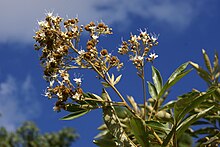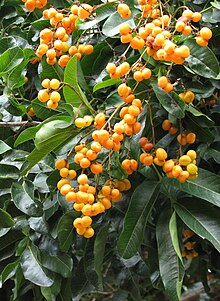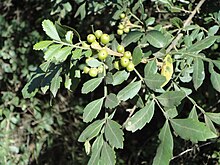Soap tree plants
| Soap tree plants | ||||||||||||
|---|---|---|---|---|---|---|---|---|---|---|---|---|

Bladder Ash ( Koelreuteria paniculata ) |
||||||||||||
| Systematics | ||||||||||||
|
||||||||||||
| Scientific name | ||||||||||||
| Sapindaceae | ||||||||||||
| Yuss. |
The soap tree plants (Sapindaceae) form a plant family that belongs to the order of the soap tree-like (Sapindales). Most of the approximately 142 genera with around 1900 species occur in tropical areas, only a few genera are distributed exclusively in the temperate zones.
description
Since the family today is made up of several families based on molecular phylogenetic reasons, very few common features are known to date.
They are mostly woody plants: trees , bushes or lianas ; herbaceous plants are rarely found . They are evergreen or deciduous. The leaves are alternate and spiral or opposite to the branches. The mostly functionally unisexual flowers are four or five-fold. Most three (two to six) carpels have become an ovary grown. Very different fruits are formed. The seeds often have an aril , which can be poisonous as long as they are immature.
distribution
The soap tree plants are particularly richly developed in the tropics . They colonize all of tropical South America , Africa and Asia , as well as Australia , New Zealand and Oceania . In the temperate zones of the northern hemisphere ( North America , Europe and East Asia ) only a few genera such as the maples ( Acer ) occur.
Systematics
The family was established in 1789 under the name "Sapindi" by Antoine Laurent de Jussieu in Genera Plantarum , p. 246. Synonyms for Sapindaceae Juss. are: Aceraceae Juss. , Aesculaceae Burnett , Allophylaceae Martinov , Dodonaeaceae Kunth ex Small , Hippocastanaceae A.Rich. , Koelreuteriaceae J. Agardh , Paulliniaceae Durande nom. inval., Paviaceae Horan. The botanical name is made up of the Latin words sapo for soap and India for India.
The Sapindaceae family is divided into four subfamilies; it includes about 142 genera with 1600 to 1900 species .
Studies between around 2000 and 2009 have shown that the genera of the previous maple family (Aceraceae) and the horse chestnut family (Hippocastanaceae), classified in the subfamily of the horse chestnut family ( Hippocastanoideae ), must also be grouped in the soap tree family. Common to all Sapindaceae is originally the formation of a disc at the base of the flower , which is secondarily absent in wind-pollinated species. The four families are based on the construction of the ovary distinguished: the Sapindoideae have only a single ovule , the Hippocastanoideae have two ovules that Dodonaeoideae have two to several ovules and Xanthoceroideae six to eight ovules per ovary compartment (corresponds to a carpel) on. This corresponds to the opinion of the family Sapindaceae according to AGP II and AGP III ( Angiosperm Phylogeny Group ).
Here are the subfamilies with their genera:
- Subfamily Hippocastanoideae Burnett : It contains four genera with about 130 species.
- Subfamily Sapindoideae Burnett : It contains about 135 genera with 1185 species.



- Subfamily Dodonaeoideae Burnett : Most species are found in Australia and Southeast Asia. For a long time it only contained two genera with around 70 species. Today it contains about 20 genera:
-
Arfeuillea Pierre ex Radlk. : With only one type:
- Arfeuillea arborescens Pierre ex Radlk. ; it occurs in Southeast Asia.
- Averrhoidium Baill. : Of the four or so species, one occurs in Mexico and the others thrive in the lowlands of South America.
- Cossinia Comm. ex Lam. : With about five types; they occur in the Mascarene Islands, the Fiji Islands, New Caledonia and in Eastern Australia.
- Conchopetalum Radlk. : The only two species occur only in Madagascar.
- Diplopeltis Endl. : Contains about five species that are found in northwestern Australia.
- Distichostemon F. Muell. : It contains about six species that are found in Australia.
- Dodonaea Mill .: The approximately 65 to 70 species are distributed in tropical and temperate Africa, on the Pacific islands and mainly in Australia (61 species).
- Doratoxylon Thouars ex Benth. & Hook. f. : Of the approximately six species, five are found in Madagascar and one in Mauritius .
-
Euchorium Ekman & Radlk. : It contains only one type:
- Euchorium cubense Ekman & Radlk. : It only occurs in Cuba .
-
Euphorianthus Radlk. : It is a monotypical genus with the only species:
- Euphorianthus euneurus (Miq.) PWLeenhouts : It occurs in eastern Malesia from the Philippines to Vanuatu , the New Hebrides .
-
Eurycorymbus Hand.-Mazz. : It contains only one type:
- Eurycorymbus cavaleriei (H.Lév.) Rehder & Handel-Mazzetti : It occurs in laurel forests at altitudes between 300 and 1400 meters in China.
- Exothea Macfad. : The three species occur in Mexico, Guatemala, Colombia, Ecuador and on the West Indies.
- Filicium Thwaites ex Benth. & Hook. f. : It contains about three types.
- Ganophyllum flower : With only two species, one in western and central Africa, the other from the Andaman and Nicobar Islands to northeastern Australia and the Solomon Islands , all over Malesia.
- Harpullia Roxb. : The approximately 26 species occur in India, Sri Lanka, southeast China, Malesia, Australia, New Caledonia and Tonga .
-
Hippobromus Eckl. & Zeyh. : It contains only one type:
- Hippobromus pauciflorus Radlk. : It comes along the east coast of South Africa from the Eastern Cape , via KwaZulu-Natal to Swaziland and then inland through the Transvaal , Limpopo , Mpumalanga to Soutpansberg . It is considered in the red list of endangered plant species in South Africa as “least concern” = “not endangered”.
- Llagunoa Ruiz & Pav .: The three to four species occur in the highlands of the Andes of South America.
-
Loxodiscus Hook. f. : It contains only one type:
- Loxodiscus coriaceus Hook. f. : It occurs only in New Caledonia.
-
Magonia A.St.-Hil. : It contains only one type:
- Magonia pubescens A.St.-Hil. : It occurs in Brazil, Bolivia and Paraguay.
- Majidea J. Kirk ex Oliv. : The approximately 24 species occur in Africa and Madagascar.
-
Arfeuillea Pierre ex Radlk. : With only one type:
- Subfamily Xanthoceroideae Thorne & Reveal (Perhaps in a new family Xanthoceraceae Buerki, Callm. & Lowry ): It contains only one genus:
-
Xanthoceras Bunge : It is a monotypic genus with the only species:
- Yellow Horn ( Xanthoceras sorbifolium Bunge ): It is native to northern and northeastern China and Korea.
-
Xanthoceras Bunge : It is a monotypic genus with the only species:
use
Many maple species and varieties are used as ornamental plants in parks and gardens in the temperate latitudes. Also bubble ash , horse chestnut species and cultivars ( Aesculus ) are ornamental trees for temperate latitudes.
The wood of many Acer species is used in a variety of ways, see maple wood . Some Aesculus species are used to produce wood. Many tropical species are used to produce wood. There are two types of Pometia in the trade as “kasai”, “matoa”, “megan” and “taun”. Harpullia pendula also makes good wood.
Different types are used medicinally, as vegetables or as fish poison. In some genera there are ornamental plants Cardiospermum , Dictyoneura , Filicium , Koelreuteria , Lepisanthes for tropical areas. Fenced in with Dodonaea angustifolia . Dodonaea angustifolia and Filicium species serve as shade trees . Many species from the Sapindaceae family provide edible seeds or fruits: Longan ( Dimocarpus longan ), Litchi ( Litchi chinensis ) or Rambutan ( Nephelium lappaceum ).
Akee ( Blighia sapida ) is also used to obtain food . Some Diploglottis TYPES provide jams and juices. The leaves and young shoots of Cardiospermum halicacabum and Koelreuteria paniculata are cooked like spinach. The flowers and leaves of yellow horn ( Xanthoceras sorbifolium ) are eaten cooked. Maple syrup is well known.
The fruit peels of the western soap tree ( Sapindus saponaria ) and the bark of Jagera pseudorhus are used to make soap. The fruits of the soapnut tree ( Sapindus mukorossi ) or products made from them are also used for washing .
swell
- The Sapindaceae family on the AP website . (Section systematics and description)
- Sven Buerki, F. Forest, P. Acevedo-Rodríguez, Martin W. Callmander, JA Nylander, M. Harrington, I. Sanmartín, Philippe Küpfer & Nadir Alvarez: Plastid and nuclear DNA markers reveal intricate relationships at subfamilial and tribal levels in the soapberry family (Sapindaceae) , In: Molecular Phylogenetics and Evolution , Volume 51, Issue 2, 2009, pp. 238-258: full text PDF, 476 kB.
- Nianhe Xia & Paul A. Gadek: Sapindaceae in der Flora of China , Volume 12, 2007, p. 6: Online and Tingzhi Xu, Yousheng Chen, Piet C. de Jong, Herman John Oterdoom & Chin-Sung Chang: Aceraceae in der Flora of China , Volume 11, 2008. P. 516: Online. (Section description)
- Sven Buerki, Porter P. Lowry II, Nadir Alvarez, Sylvain G. Razafimandimbison, Philippe Küpfer & Martin W. Callmander: Phylogeny and circumscription of Sapindaceae revisited: molecular sequence data, morphology and biogeography support recognition of a new family, Xanthoceraceae , In: Plant Ecology and Evolution , Volume 143, Issue 2, 2010, pp. 148–159: doi : 10.5091 / plecevo.2010.437 full text PDF. (Aceraceae and Hippocastanaceae probably not in Sapindaceae and a new family Xanthoceraceae Buerki, Callm. & Lowry.)
Individual evidence
- ↑ First publication scanned at biodiversitylibrary.org.
- ↑ a b Sapindaceae in the Germplasm Resources Information Network (GRIN), USDA , ARS , National Genetic Resources Program. National Germplasm Resources Laboratory, Beltsville, Maryland. Retrieved August 3, 2013.
- ↑ Sven Buerki, Porter P. Lowry II, Nadir Alvarez, Sylvain G. Razafimandimbison, Philippe Küpfer & Martin W. Callmander: Phylogeny and circumscription of Sapindaceae revisited: molecular sequence data, morphology and biogeography support recognition of a new family, Xanthoceraceae , In : Plant Ecology and Evolution , Volume 143, Issue 2, 2010, pp. 148–159: doi : 10.5091 / plecevo.2010.437 full text PDF. (Aceraceae and Hippocastanaceae probably not in Sapindaceae and a new family Xanthoceraceae Buerki, Callm. & Lowry.)
- ↑ Nianhe Xia & Paul A. Gadek: Sapindaceae in der Flora of China , Volume 12, 2007, p. 6: Online and Tingzhi Xu, Yousheng Chen, Piet C. de Jong, Herman John Oterdoom & Chin-Sung Chang: Aceraceae in der Flora of China , Volume 11, 2008. P. 516: Online.
- ↑ Hippobromus pauciflorus in the Red List of South African Plants . Classified by: JE Victor & AE van Wyk, 2005. Accessed August 10, 2013
- ↑ Acer spp. at commercial timber from HG Richter & MJ Dallwitz.
- ↑ Aesculus spp. for commercial timbers at DELTA by HG Richter & MJ Dallwitz.
- ↑ Pometia pinnata for commercial timbers at DELTA by HG Richter & MJ Dallwitz.
- ↑ On the use of Sapindaceae in the Flora Malesiana . ( Page no longer available , search in web archives ) Info: The link was automatically marked as defective. Please check the link according to the instructions and then remove this notice.
- ↑ Entries on Sapindaceae in Plants For A Future . Retrieved August 3, 2013.
Web links and additional literature
- Information sheet Kasai, Matoa (PDF; 945 kB), on gdholz.net, accessed on November 14, 2016.
- The family of Sapindaceae , the family of the Aceraceae , and the family of Hippocastanaceae at DELTA L. Watson and MJ Dallwitz .
- Pedro Acevedo-Rodríguez: Neotropical Sapindaceae : at Neotropikey .
- Sven Buerki, F. Forest, N. Salamin & Nadir Alvarez: Comparative performance of supertree algorithms in large data sets using the soapberry family (Sapindaceae) as a case study , In: Systematic Biology. Volume 60, 2011, pp. 32–44: doi : 10.1093 / sysbio / syq057 .
- Sven Buerki, F. Forest, Martin W. Callmander, PP Lowry II, DS Devey & J. Munzinger: Phylogenetic inference of New Caledonian lineages of Sapindaceae: molecular evidence requires a reassessment of generic circumscriptions , In: Taxon. Volume 61, 2012, pp. 109–119.
- Sven Buerki, F. Forest, T. Stadler & Nadir Alvarez: The abrupt climate change at the Eocene – Oligocene boundary and the emergence of South-East Asia triggered the spread of sapindaceous lineages , In: Annals of Botany. Volume 112, Issue 1, pp. 151-60 2013. doi : 10.1093 / aob / mct106 .
